中国北方最大的浅水湿地湖泊抗生素的发生、生物积累、生态风险及指标筛选
IF 6.3
2区 环境科学与生态学
Q1 ENVIRONMENTAL SCIENCES
引用次数: 0
摘要
抗生素在水生环境中广泛存在,因为它们在人类保健和畜牧业中被广泛使用。然而,关于浅水湿地湖泊中抗生素在水生生物中的发生和生物积累的研究仍然有限。本研究调查了中国北方最大的浅水湿地湖泊白洋湖中10种常用抗生素的发生和生物蓄积情况。结果表明,地表水中以磺胺类和氟喹诺酮类抗生素为主,沉积物中以氟喹诺酮类和大环内酯类抗生素为主。氟喹诺酮类药物在包括动物和植物在内的目标水生生物(鲫鱼和芦苇)中具有显著的生物蓄积潜力。抗生素在鲫鱼体内的生物蓄积与溶解度有关,而在芦苇体内则与辛醇-水分配系数和分子量有关。生态风险评估表明,大多数抗生素具有最小至低风险水平。但有4种抗生素例外:克拉霉素(12.5%)和磺胺甲新唑(6.25%)在地表水样品中存在高风险,而诺氟沙星(25.0%)和环丙沙星(25.0%)在沉积物样品中存在高风险。基于(1)浓度高、(2)检测频繁、(3)生物蓄积能力和(4)生态风险水平4个标准,将诺氟沙星、环丙沙星和罗红霉素确定为加强局部抗生素污染监测和控制的关键指标抗生素。本研究有助于深入了解白杨湖抗生素污染现状、生物蓄积特征和生态风险,为抗生素污染监测和调控提供依据。本文章由计算机程序翻译,如有差异,请以英文原文为准。

Antibiotics in northern China's largest shallow wetland lake: Occurrence, bioaccumulation, ecological risk, and indicator screening
Antibiotics are widespread in aquatic environments due to their extensive use in human healthcare and animal husbandry. However, research on the occurrence and bioaccumulation of antibiotics in aquatic organisms within shallow wetland lakes remains limited. This study investigated the occurrence and bioaccumulation of ten commonly used antibiotics in the Baiyang Lake, northern China's largest shallow wetland lake. The results indicated that sulfonamides and fluoroquinolones were the predominant antibiotics in surface water, whereas fluoroquinolones and macrolides were more prevalent in sediment. Fluoroquinolones demonstrated significant potential for bioaccumulation in targeted aquatic organisms, including both animals and plants (Carassius auratus and Phragmites australis). The bioaccumulation of antibiotics in Carassius auratus was correlated with their solubility, whereas in Phragmites australis, this was associated with their octanol-water partition coefficients and molecular weights. Ecological risk assessment indicated that most antibiotics posed minimal to low risk levels. However, four antibiotics were exceptions: clarithromycin (12.5 %) and sulfamethoxazole (6.25 %) presented a high risk in surface water samples, while norfloxacin (25.0 %) and ciprofloxacin (25.0 %) posed a high risk in sediment samples. Norfloxacin, ciprofloxacin, and roxithromycin were identified as key indicator antibiotics for enhancing the local monitoring and control of antibiotic contamination based on four criteria: (1) high concentrations, (2) frequent detection, (3) capacity for bioaccumulation, and (4) ecological risk levels. This study contributes to a deeper understanding of the status of antibiotic contamination, bioaccumulation characteristics, and ecological risk in Baiyang Lake, thereby supporting efforts to monitor and regulate antibiotic pollution.
求助全文
通过发布文献求助,成功后即可免费获取论文全文。
去求助
来源期刊

Journal of Environmental Sciences-china
环境科学-环境科学
CiteScore
13.70
自引率
0.00%
发文量
6354
审稿时长
2.6 months
期刊介绍:
The Journal of Environmental Sciences is an international journal started in 1989. The journal is devoted to publish original, peer-reviewed research papers on main aspects of environmental sciences, such as environmental chemistry, environmental biology, ecology, geosciences and environmental physics. Appropriate subjects include basic and applied research on atmospheric, terrestrial and aquatic environments, pollution control and abatement technology, conservation of natural resources, environmental health and toxicology. Announcements of international environmental science meetings and other recent information are also included.
 求助内容:
求助内容: 应助结果提醒方式:
应助结果提醒方式:


